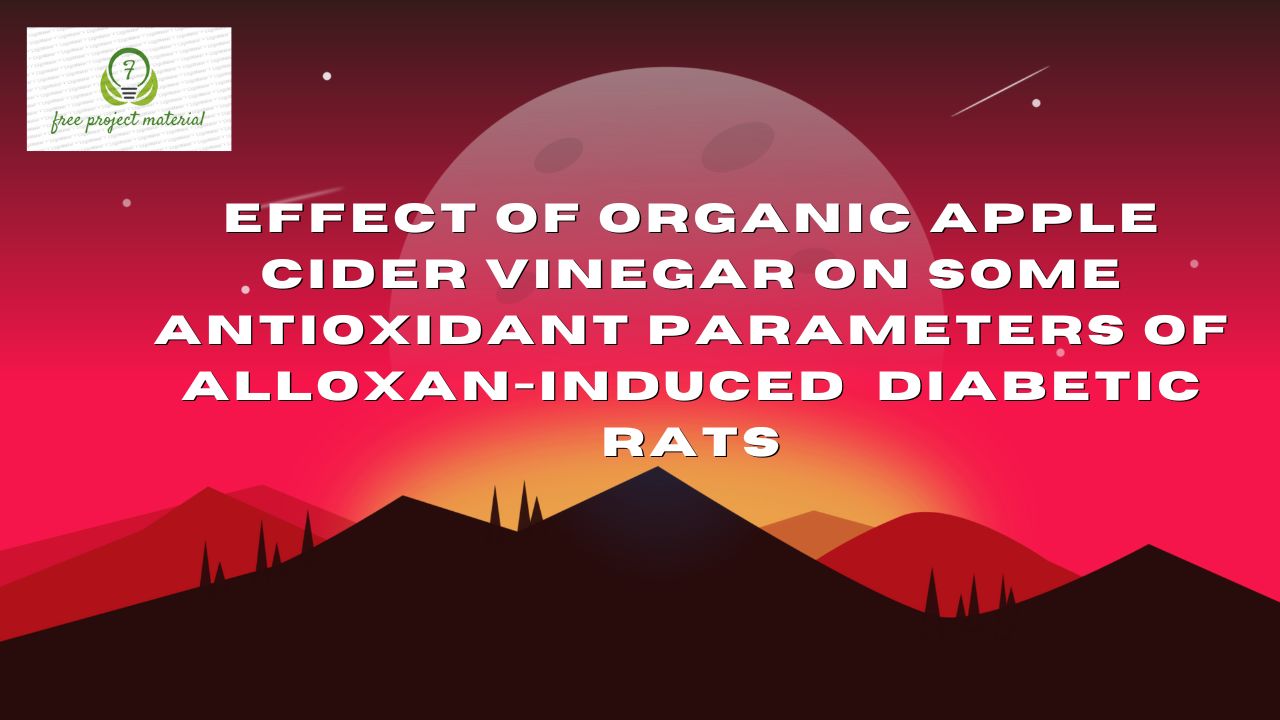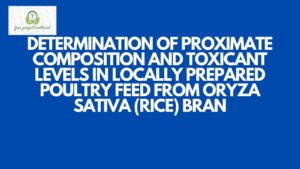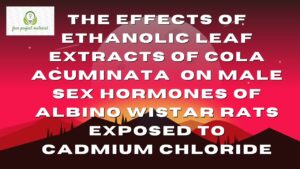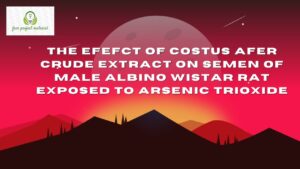ABSTRACT
The effect of organic Apple cider vinegar on some antioxidant parameters of alloxan-induced diabetic rats was investigated. The antioxidants analysed were Superoxide dismutase (SOD), Catalase (CAT), and Glutathione peroxidase (GPX). Twenty-five (25) male albino wistar rats weighed between 73-352g were randomly assigned to 5 groups of 5 animals each. Group1 serves as the control and was given distilled water and commercial rat chow, group 2 which was negative control was induced with 150mg/kg body weight of alloxan. Group 3, 4 and 5 were induced with 150mg/kg body weight of alloxan, thereafter 0.5ml, 1.0ml and 1.5ml of 10% organic apple cider vinegar was administered respectively every other day for 21 days. The treatment was done through oral route and lasted for 21days. The animals were sacrificed and blood was gotten through cardiac puncture. The mean SOD activity revealed a non-significant decrease (P>0.05) in group 2 and 3 except groups 4 and 5 that showed significant increased (P<0.05) when compared to the control. Serum catalase level revealed a non-significant increased (P>0.05) in group 2, 3 and 5 except for group 4 which showed a non-significant decrease when compared to the control. A significant increase (P<0.05) was observed in group 2 and 5 of serum Glutathione peroxidase, group 3 showed a non-significant decrease (P>0.05) but group 4 showed a non-significant increased (P>0.05) when compared to the control. This result suggested that apple cider vinegar has improvement activity on antioxidant enzymes and may be beneficial in protecting against oxidative stress in alloxan-induced diabetes.
Keywords: Organic apple cider vinegar, alloxan, albino wistar rats, superoxide dismutase (SOD), catalase (CAT), glutathione peroxidase (GPx).
TABLE OF CONTENTS
Title Page – – – – – – – – – i
Certification – – – – – – – – ii
Dedication – – – – – – – – – iii
Acknowledgement – – – – – – – iv
Abstract – – – – – – – – – v
Table of Contents – – – – – – – – vi
List of Plates – – – – – – – – x
List of Tables – – – – – – – – xi
List of Figures – – – – – – – – xii
CHAPTER ONE: INTRODUCTION
1.1 Background of the Study – – – – – 1
1.2 Aims and Objectives – – – – – – 3
1.2.1 Aims – – – – – – – – – 5
1.2.2 Objectives – – – – – – – – 5
1.3 Significance of the Study – – – – – 6
1.4 Scope and Limitations of the Study – – – – 6
1.5 Definition of Terms – – – – – – 7
1.6 Abbreviations – – – – – – – 8
CHAPTER TWO: LITERATURE REVIEW
2.1. Diabetes – – – – – – – – 10
2.2. Description of Apple Cider Vinegar – – – – 11
2.3 Production of Apple Cider Vinegar – – – – 14
2.4 Fermentation of Apple Cider Vinegar – – – – 15
2.5 Pharmacological Activity of Apple Cider Vinegar – – 17
2.5.1 Antidiabetic Activity – – – – – – 17
2.5.2 Anti-inflammatory Activity – – – – – 18
2.5.3 Antimicrobial Activity – – – – – – 19
2.5.4 Hepato Protective Activity – – – – – 20
2.5.5 Antioxidant Activity – – – – – – 21
2.5.6 Antifungal Activity – – – – – – 23
2.5.7 Anticancer Activity – – – – – – 24
2.6 Molecular Formula and Structural Formula of alloxan – 25
2.7 Mechanism of Action of Alloxan – – – – 26
2.8 Biological Effects of Alloxan – – – – – 28
2.9 Antioxidant Enzymes – – – – – – 31
2.9.1 Superoxide dismutase (SOD) – – – – – 31
2.9.2 Glutathione peroxidase (GPx) – – – – – 32
2.9.3 Catalase – – – – – – – – 34
CHAPTER THREE: MATERIALS AND METHODS
3.1 Materials – – – – – – – – 36
3.2 Methods – – – – – – – – 37
3.2.1 Sample Collection and Preparation – – – – 37
3.2.2 Preparation of Samples – – – – – – 38
3.2.3 Experimental Animals – – – – – – 38
3.2.4 Experimental Design and Grouping of Animals – – 39
3.2.5 Collection of Blood – – – – – – 40
3.3 Determination of the Effect of Treatment on the
Experimental Animal – – – – – – 41
3.3.1 Determination of Catalase Level Activity – – – 41
3.3.2 Determination of Glutathione peroxidase level – – 42
3.3 Determination of Superoxide dismutase level – – 43
CHAPTER FOUR: RESULTS AND DISCUSSION
4.1 Physiological and Morphological Changes Observed – 46
4.2 Results – – – – – – – – 48
4.3 Discussion – – – – – – – – 50
CHAPTER FIVE: CONCLUSION AND RECOMMENDATION
5.1 Conclusion – – – – – – – – 54
5.2 Recommendation – – – – – – – 54
References
LIST OF PLATES
Plate1: Picture of Organic Apple Cider Vinegar
LIST OF TABLES
Table 4.1: Effect of apple cider vinegar on some antioxidant parameters (SOD, CAT and GPX) of alloxan-induced Diabetic rats.
LIST OF FIGURES
Figure 1: Structure of Alloxan
CHAPTER ONE
INTRODUCTION
1.1 Background of the Study
Apple cider vinegar (ACV) is a liquid product of fermentation of apples. It has a brownish yellow color and has been in use for hundreds of years. In the year 400 BC, Hippocrates, the father of modern medicine prescribed the mixture; oxymel made of honey and apple cider vinegar for treatments of persistent coughs and other diseases (Johnston and Gaas, 2006). It has been widely used in various dosage forms in alternative medicine for several conditions such as diabetes (Mahmoodi et al., 2013), obesity (Iman et al., 2015) hypertension (Jabir et al., 2011) and hyperlipidemia (Hamed and Matar, 2014). The beneficial effects of apple cider vinegar are attributed to its acetic acid content, apple pectin and other phytochemicals such as polyphenolic compounds and flavonoids (Soltan and Shehata, 2012 ; Mohamad et al., 2015) .
Oxidative stress, defined as a measure of steady levels of reactive oxygen species (ROS) or oxygen radical in the biological system, is a resultant of over production of free radicals i.e. reactive oxygen species (ROS), which exceeds the body’s antioxidant defense mechanisms (Mallick et al., 2015). Severe and persistent stress elevates reactive oxygen species (ROS) production by metabolic and physiological processes; causing cellular damage (Budak et al., 2014). Physical restraint is a well-known stress model, which increases oxidative processes leading to the generation of reactive oxygen species which may propagate the initial attack on lipid rich membranes to cause lipid peroxidation (Fyiad, 2012). Excessive reactive oxygen species production resulting from stress hormones leads to an increase in lipid peroxidation of the cellular structures which play an important role in pathogenesis of degenerative diseases, such as atherosclerosis, oxidative damage to DNA, and carcinogenesis. Reactive oxygen species are kept at physiologically optimal levels by the endogenous antioxidant defense systems as well as natural exogenous antioxidants derived from the diet (Naziroglu et al., 2012). The endogenous antioxidant system includes the array of antioxidant enzymes; cellular and mitochondrial superoxide dismutases (copper/zinc (CuZnSOD) and Mn2+-dependent superoxide dismutase (MnSOD), catalase (CAT), glutathione peroxidase (GPx) and glutathione reductase (GLR), and non-enzymatic antioxidants such as glutathione (GSH).
Diabetes mellitus has been considered as one of the major health concerns all around the world today (Stolar et al., 2008; Kruger et al., 2012). Experimental animal models are one of the best strategies for the understanding of pathophysiology of any disease in order to design and develop the drugs for its treatment (Rees and Alcolado, 2005; Chatzigeorgiou et al., 2009). Numerous animal models have been developed for the past few decades for studying diabetes mellitus and testing antidiabetic agents that include chemical, surgical and genetic manipulations (Srinivasan and Ramarao, 2007). One of the most potent methods to induce experimental diabetes mellitus is chemical induction by Alloxan (Etuk, 2010). It is a well-known diabetogenic agent that is used to induce Type I diabetes in experimental animals (Bianca et al., 2004). Alloxan is a urea derivative which causes selective necrosis of the β-cells of pancreatic islets. In addition, it has been widely used to produce experimental diabetes in animals such as rabbits,rats, mice and dogs with different grades of disease severity by varying the dose of alloxan used (Etuk, 2010 ; Iranloye et al., 2011). As it has been widely accepted that alloxan selectively destroys the insulin-producing beta-cells found in the pancreas, hence it is used to induce diabetes in laboratory animals. The toxic action of alloxan on pancreatic beta cells involve oxidation of essential sulphydryl (-SH groups), inhibition of glucokinase enzyme, generation of free radicals and disturbances in intracellular calcium homeostasis (Dhanesha et al., 2012). The underlying mechanism involves the selective uptake of the compound due to its structural similarity to glucose as well as highly efficient uptake mechanism of the pancreatic beta-cells, (Lenzen, 2008).
1.2 Aims and Objectives of the study
1.2.1 Aims of the studies
The aim of this research project was to determine the effect of organic apple vinegar on some antioxidant parameters (Superoxide dismutase, Catalase and Glutathion peroxidase) of alloxan-induced diabetic male albino wistar rats.
1.2.2 Objectives of the Study
The objectives of the research project were to investigate;
- To observe the physical and morphological changes on the alloxan-induced diabetic male albino wistar rats after inducement and during treatment with organic apple cider vinegar.
- The effect of administration of 0.5ml, 1ml and 1.5 ml of organic apple cider vinegar on the Superoxide dismutase (SOD) level of alloxan-induced diabetic male albino wistar rats.
- The effect of administration of 0.5ml, 1ml and 1.5 ml organic apple cider vinegar on the Glutathione peroxidase (GPx) level of alloxan-induced diabetic male albino wistar rats.
- The effect of administration of 0.5ml, 1ml and 1.5 ml organic apple cider vinegar on the Catalase (CAT) level of alloxan-induced diabetic male albino wistar rats.
1.3 Significance of the Study
- The result obtained from this research work will be useful to medical doctors, pharmacist, herbalist etc. as it will help in ascertaining the efficacy of organic apple cider vinegar in improving antioxidant enzymes
- This study will serve as a source of information to the public in order to guide their usage herbal mixture
- The study will also serve as reference material to researchers and students in this field.
1.4 Scope and Limitations
This research work was limited to the investigation of effect of organic apple vinegar on some antioxidant parameters (Superoxide dismutase,
Catalase and Glutathion peroxidase) of alloxan-induced diabetic male albino wistar rats.
The scope was also limited by time as well as financial constraint.
1.5 Definition of Terms
Alloxan is a toxic glucose analogue, which selectively destroys insulin-producing cells in the pancreas (that is, beta cells) when administered to rodents and many other animal species.
Apple cider vinegar, or cider vinegar, is a vinegar made from fermented apple juice and used in salad dressings, marinades, vinaigrettes, food preservatives, and chutneys.
Superoxide dismutase (SOD) scientifically, is an enzyme that alternately catalyzes the dismutation of the superoxide radical into either ordinary molecular oxygen or hydrogen peroxide.
Catalase is a key enzyme which uses hydrogen peroxide, a nonradical ROS, as its substrate. This enzyme is responsible for neutralization through decomposition of hydrogen peroxide, thereby maintaining an optimum level of the molecule in the cell which is also essential for cellular signaling processes.
Glutathione Peroxidase (GPx) is a cytosolic enzyme that catalyzes the reduction of hydrogen peroxide to water and oxygen as well as catalyzing the reduction of peroxide radicals to alcohols and oxygen.
1.6 Abbreviations
SOD Superoxide dismutase
Gpx Glutathione peroxidase
ACV Apple Cider Vinegar
AAB Acetic Acid Bacteria
AD Autonomic dysreflexia
ROS Reactive Oxygen Species
PHGPX Phospholipids Hydroperoxide Glutathion peroxidase
CAT Catalase
ATP Adenosine triphosphate
DNA Deoxyribonucleic acid
HDL High-density lipoprotein
LDL Low-density lipoprotein
VLDL Very-low-density lipoprotein
TPA Tissue-type plasminogen activator
ANOVA Analysis of Variance



